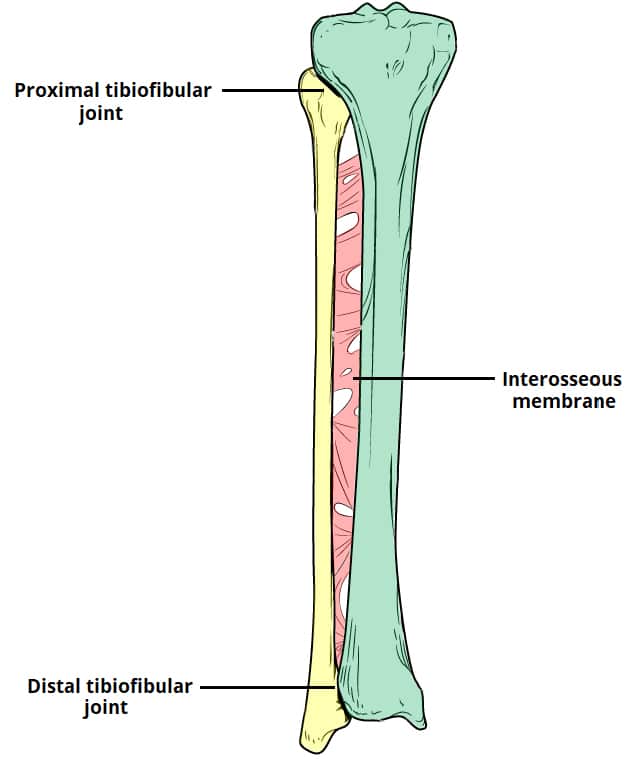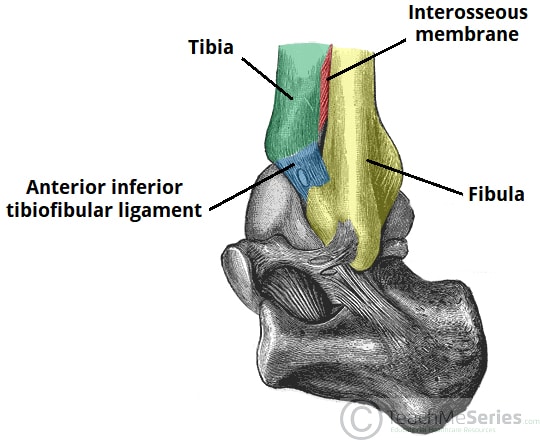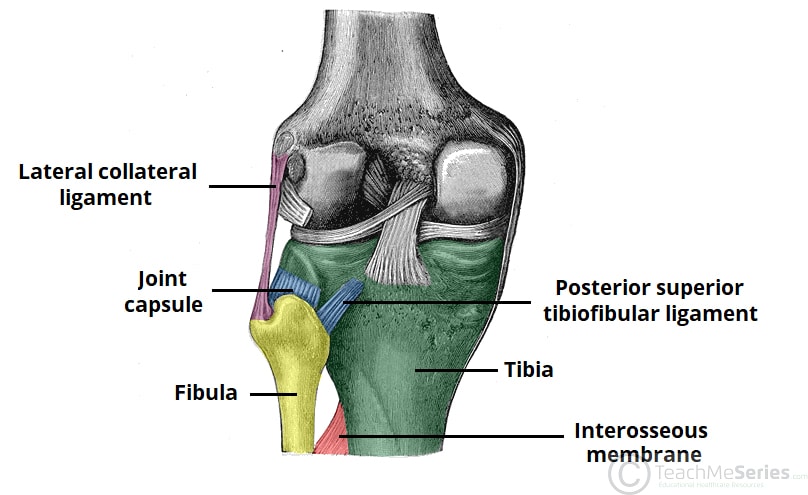The proximal and distal tibiofibular joints refer to two articulations between the tibia and fibula of the leg. These joints have minimal function in terms of movement but play a greater role in stability and weight-bearing.
In this article, we shall look at the anatomy of the proximal and distal tibiofibular joints – their structures, neurovascular supply and clinical relevance.

Fig 1
Anterior view of the right proximal and distal tibiofibular joints.
Premium Feature
3D Model
Proximal Tibiofibular Joint
Articulating Surfaces
The proximal tibiofibular joint is formed by an articulation between the head of the fibula and the lateral condyle of the tibia.
It is a plane type synovial joint; where the bones to glide over one another to create movement.
Supporting Structures
The articular surfaces of the proximal tibiofibular joint are lined with hyaline cartilage and contained within a joint capsule.
The joint capsule receives additional support from:
- Anterior and posterior superior tibiofibular ligaments – span between the fibular head and lateral tibial condyle
- Lateral collateral ligament of the knee joint
- Biceps femoris – provides reinforcement as it inserts onto the fibular head.
Neurovascular Supply
The arterial supply to the proximal tibiofibular joint is via the inferior genicular arteries and the anterior tibial recurrent arteries.
The joint is innervated by branches of the common fibular nerve and the nerve to the popliteus (a branch of the tibial nerve).
Distal Tibiofibular joint
Articulating Surfaces
The distal (inferior) tibiofibular joint consists of an articulation between the fibular notch of the distal tibia and the fibula.
It is an example of a fibrous joint, where the joint surfaces are by bound by tough, fibrous tissue.
Supporting Structures
The distal tibiofibular joint is supported by:
- Interosseous membrane – a fibrous structure spanning the length of the tibia and fibula.
- Anterior and posterior inferior tibiofibular ligaments
- Inferior transverse tibiofibular ligament – a continuation of the posterior inferior tibiofibular ligament.
As it is a fibrous joint, the distal tibiofibular joint does not have a joint capsule (only synovial joints have a joint capsule).


Fig 3
The left distal tibiofibular joint, supported by the interosseous membrane and the anterior inferior tibiofibular ligament. The posterior ligaments are not visible in this illustration.
Neurovascular Supply
Arterial supply to the distal tibiofibular joint is via branches of the fibular artery and the anterior and posterior tibial arteries.
The nerve supply is derived from the deep peroneal and tibial nerves.
Clinical Relevance
Dislocation of the Proximal Tibiofibular Joint
A proximal tibiofibular joint dislocation is a rare and often missed diagnosis. It accounts for <1% of all knee injuries.
The typical mechanism of injury is a fall onto an adducted and flexed knee. They can also occur as a result of high-energy trauma.
Common clinical features include inability to weight-bear, lateral knee pain and tenderness/prominence of the fibular head.
This type of injury is typically treated with a closed reduction (a reduction is a procedure to restore the joint to its natural alignment). Complications of proximal tibiofibular joint dislocation include common fibular nerve injury (the nerve winds around the neck of the fibula), and recurrent dislocation.
